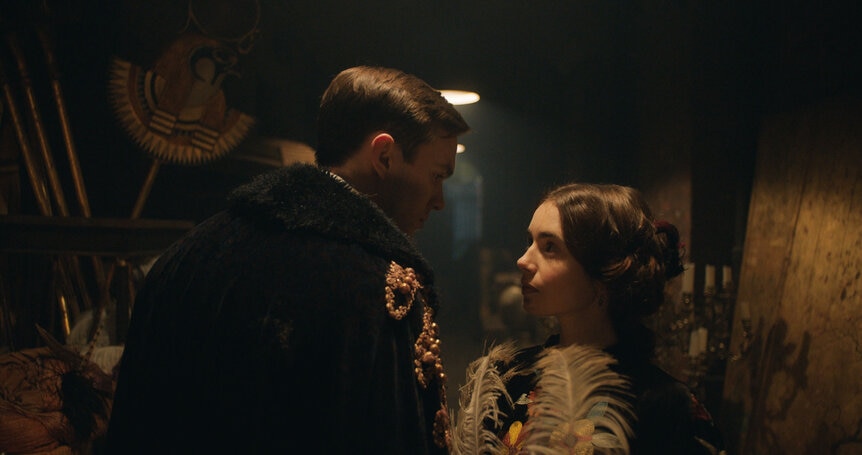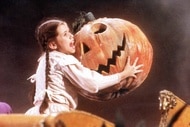Create a free profile to get unlimited access to exclusive videos, sweepstakes, and more!
How the J. R. R. Tolkien biopic connects his life story to the world of Lord of the Rings

To most of the world, J.R.R. Tolkien is just the British man who wrote The Hobbit and The Lord of the Rings, but to legions of diehard fans, Tolkien is known as "The Professor," an intellectual figure whose legacy borders on a real religion. Fanatics don't just stop at reading his novels — they read his journals and letters, analyze his sketches, and debate the real man's opinions, relationships and habits as fervently as other fandoms discuss Easter eggs.
Throughout fandoms, there is no real equivalent yet to how deep Tolkien fans like to dive. It's not as if readers have spent eighty years dissecting J.K. Rowling's undergraduate notebooks or piecing together a new Amazon series from random thoughts in Frank Herbert's diary. That's partly due to the amount of time that has passed since Tolkien published The Hobbit, but as Fox Searchlight's new biopic Tolkien makes clear, the obsession with his personal life is also warranted.
The guy lived a life far more exceptional than the average novelist. It's a story any audience member can feel invested in, partly because accessing the film requires only a cursory knowledge of The Lord of the Rings. Wizards, dragons, powerful rings, good vs evil — if you know Tolkien's stories involve those vague concepts, you're good.
Tolkien doesn't do a disservice to its subject's hyper-detailed fictional worlds, but the film does suggest that The Lord of the Rings reflected moments and episodes in his life, borne from references Tolkien collected from his mother, the Catholic church, the group home he grew up in, his friends at his private school, his unlikely love story with his wife, and the horrific events of World War I. All of the little tie-ins — four boyish, hobbit-like friends embarking on a dark adventure, a quirky Gandalf-like professor who wanders off into the woods mid-sentence — feel earned, possibly because they're so subtle.
When he daydreams, he sees knights riding into battle. When he catches trench fever, those heroic figures are twisted into fallen knights and black riders, lopping off the heads of British soldiers. Tolkien didn't invent the concept of knights, wizards, or even evil rings, as his biopic makes clear, but he eventually combined all these familiar, ancient tropes from classic literature into a new epic, even subverting some of the images.
The film posits that young Tolkien entered World War I with all of these pure images of goodness in his head, only to see them twisted into something demonic. When he hallucinates from illness, director Dome Karukoski tells SYFY WIRE that Tolkien's familiar figures "start to become corrupted images he'll use later."
Throughout the film, Tolkien (Nicholas Hoult) is portrayed as an insular, earnest genius attracted to his polar opposite. His eventual wife Edith (Lily Collins) shares his love of heroic epics but finds his obsession with context-free linguistic science boring. His friends at school are closeted artists and the sons of high-class British aristocrats —they don't face the consequences Tolkien does, as a scholarship student, and they can't fathom why he'd still be hung up on a girl from back home. It's interesting that even among highly educated, posh British boys his age, Tolkien came off earnest, moral, and even a bit corny. The guy was drawing wizards instead of going on dates, after all.
It feels logical that an imaginative, emotional boy who was exposed to the first World War during his formative years might grow up to write a story about war for the world's end. Nicholas Hoult told SYFY WIRE that he loved Tolkien's writing as a kid, but didn't realize that he knew nothing about the actual man until he was given the script for Tolkien.
"He had the most remarkable childhood, the friendships he forged and the love he found," he said. "And then all of that was wiped away by WWI. [...] I really thought about that a lot, the idea that Tolkien lost his core fellowship through war, and we lost everything they would have created."
Hoult says he's gotten in the habit of "folding aspects of the characters I play into myself" as an artist, much like the film depicts Tolkien doing all his life. "[While filming Tolkien], he language thing has been huge for me," he says. "I was probably taking it slightly for granted. Occasionally, you'll go through a script and suspect, 'well, I don’t think my character would say that,' but now I’m able to approach it a different way."
Hoult says that he felt empowered to interrogate the rhythm of his characters' dialogue, having immersed himself in Tolkien's expertise during filming.
In addition to war, friendship, and love, the unifying piece of the Tolkien puzzle is, of course, language. Unlike the fantasy characters that came before his, Tolkien's elves, orcs, dwarves, and wizards all reference unique cultures, religious fables, compendiums of original songs, and hundreds of years' worth of written history — all invented and cataloged by Tolkien himself. We don't see the young Tolkien writing out verb tenses in Sindarin, as he undoubtedly did a decade later, but when he's drunk and heartbroken, he mutters to himself in proto-Quenya, a fictional language derived from Finnish.
"We worked with several language and linguistics experts to design an earlier version of Quenya," Karukoski says. "Not the language as it exists in Middle-Earth, but the first pieces he must have put together."
That's why Karukoski, working with an original script from David Gleeson and Stephen Beresford, decided to end his story before the period in Tolkien's life that most scholars like to cite — his tenure as an Oxford professor, drawing his maps of Middle-earth, and his heated conversations about allegory and Christianity with C.S. Lewis and the other Inklings. It wasn't just a loophole so the studio could avoid getting the rights to Tolkien's characters, though that certainly helped. "Oxford, C.S. Lewis, the Inklings, they're all essential to his work," Karukoski says, "but they're not essential to his life or his formation as an artist."
We know, for instance, from Tolkien's almost compulsive journaling that he experimented with linguistics in his youth, most likely inspired by his mother teaching him several languages before school every day. We know he learned fellowship from the secret club he created with three boys at school, and we know his first brush with love eventually inspired Lúthien and Beren Erchamion.
Tolkien finds a satisfactory blend of fact and fancy, and it tells the story of a nerd who literally found himself in the trenches of a war more brutal than any of his peers could have imagined. It would have been enough of a feat for Tolkien to simply survive — the fact that he went on to publish novels that changed the course of modern literature is truly extraordinary.





























